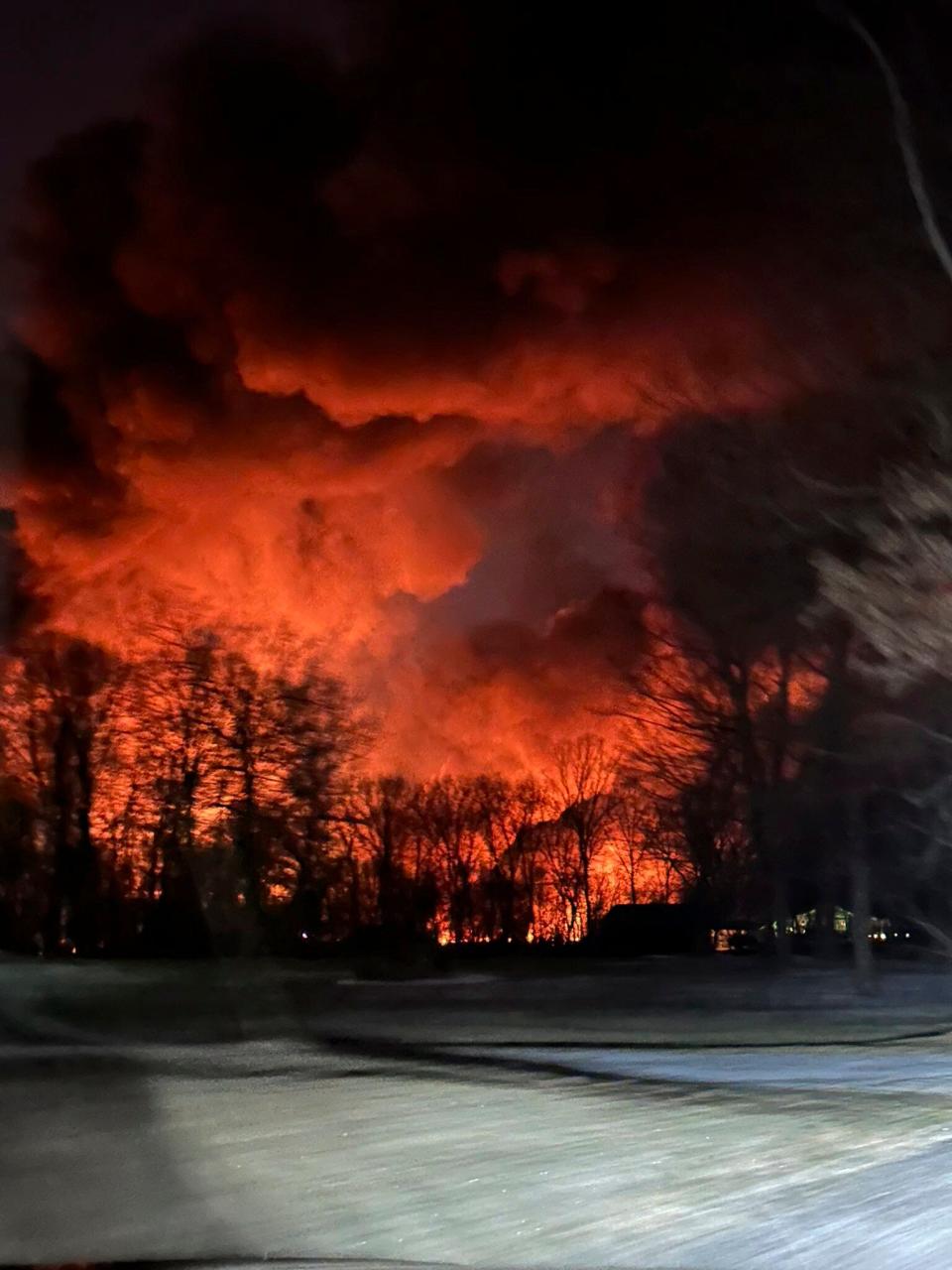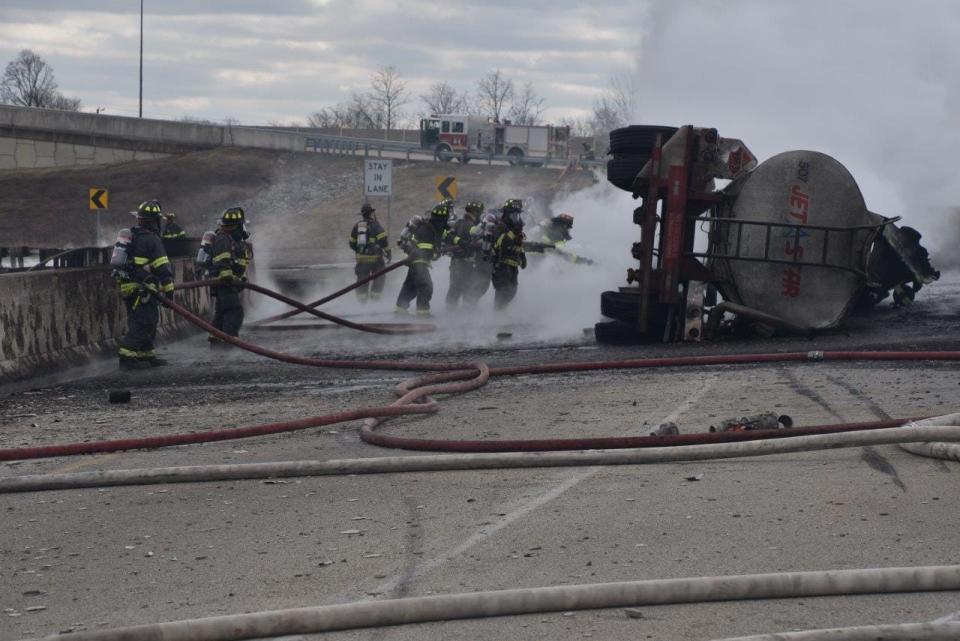Behind the numbers: Hazmat transportation accidents are on the rise in Midwest
USA TODAY analyzed a decade's worth of data from the Pipeline and Hazardous Materials Safety Administration about the movement of hazardous chemicals across Indiana, Illinois, Kentucky, Michigan and Ohio. Here are the most important takeaways revealed in the data, as well how reporters evaluated the information.
The number of highway hazmat incidents has been growing
The number of transportation-related hazmat accidents each year in the U.S. has increased steadily in the last decade, from about 16,100 incidents in 2013 to 25,300 last year, according to the federal Pipeline and Hazardous Materials Safety Administration. The same trend can be seen in the five-state region, where the annual count climbed from 3,400 to 5,300 last year.
Hazmat shipments: Huge amounts of hazardous materials pass through Midwest every day. How safe are residents?
An increase in highway accidents, both in the region and nationally, has driven these numbers. The number of rail accidents actually decreased during this time, from 86 in the region in 2013 to 51 in 2022. Accidents in the region involving air transport have remained steady at around 200 a year, while only two barge accidents with hazmat spills occurred in the entire decade.
Few accidents are deemed 'serious'
PHMSA classifies accidents as "serious" if they lead to deaths or injuries, mass evacuations, the closure of major transportation arteries, the alteration of an aircraft flight plan, or large volume of hazmat being released (more than 119 gallons or 882 pounds).
Nationally, and in the five-state region, only about 1% of incidents met that criteria. This proportion is consistent across the various modes of transportation except for rail, where 7% of accidents were deemed serious.
Across modes, about a third of incidents happened in transit, while the other two thirds happened during loading or unloading, with a small proportion happening in storage before or after transit. Accidents that happen on the move, such as derailments and crashes, are most likely to be "serious" and account for over 90% of total damages — which totaled $237 million in the region in the last decade.
One rail accident can be many times more damaging than other modes
Highway and rail accidents together made up more than 99% of damages in the last decade, both nationally and in the region. Nationally, truck accidents led in frequency and total damages, but a single rail accident can have outsized impacts. On average, it took 22 truck accidents to equal the damages of a single train accident.
Think of how one rail car often carries the equivalent of three to four truckloads of hazmat, or how trains are more likely to transport many tank cars and different substances at once, as well as for further distances. The rise of Precision Scheduled Railroading in the rail industry further incentivizes longer trains and fewer trips.
Hazmat shipments: 6 things to know about the transportation of hazardous materials in the Midwest
These intersecting factors played out in East Palestine, where 38 train cars derailed, including 11 carrying a concoction of hazardous substances including vinyl chloride, ethylhexyl acrylate, ethylene glycol monobutyl, butyl acrylate and isobutylene.
East Palestine was the decade's most expensive incident by far
After the derailment in East Palestine, PHMSA estimates put initial damages at $58 million. But Norfolk Southern's first-quarter earning’s report estimated the total damages to be many times higher, closer to $387 million.

The derailment in East Palestine is the decade’s most expensive incident by a wide margin. The next most damaging incident happened in Mount Carbon, Virginia, in 2015. This train derailment cost CSX Transportation $29 million when adjusted for inflation. In the five-state region, next most costly accident was a highway crash in Mishawaka, Indiana, that caused $20 million in damages when adjusted for inflation.
Hazmats on highways led to deaths
All of the hazmat-related fatalities of the last decade happened during truck transport. The same goes for most injuries.
Six of 73 nationwide deaths since 2013 happened in the five-state region, as well as 383 of about 1,500 total injuries. The six people who died were all drivers transporting fuel such as gasoline, killed by the fire or explosion resulting from hazmat spilling and burning during a crash.

The environmental and heath impacts of chemical releases are more difficult to track, but can have lasting impacts on affected communities. In the last decade, carriers reported 132 incidents in the region and 918 nationally where hazardous material incidents led to environmental damages or entered waterways and sewage systems.
How we looked at federal data
USA Today Network analyzed a decade of data from PHMSA’s Hazmat Incident Database, spanning Jan. 1, 2013, to May 31, 2023, as it appeared on July 3, 2023. PHMSA requires carriers to submit a report within 30 days of an incident. A state locator was not recorded in 1,402 incidents across the U.S. (<0.1%) during this time period.
Monetary data from PHMSA was adjusted for inflation as of Fiscal Year 2023 using the Bureau of Economic Statistics GDP Chained Price Index. “Total Damages” are estimates submitted by the discretion of the carrier to PHMSA and include material loss, carrier damage, property damage, response and cleanup costs. Although there are no guidelines as to how estimates are made, PHMSA requires carriers to update figures within one year if the damages exceed 10% of prior estimates.
Based on recommendations from PHMSA, USA Today Network did not include hazmats that travel by pipelines in the scope of this investigation, and focused instead on hazmat shipment by vehicles. Incident reporting requirements and designations of “serious" incidents are not the same for pipelines and include distribution lines, including those that serve businesses and homes.
Urban, suburban and rural classifications of counties were made using the Pew Research Center’s groupings of the numeric National Center for Health Statistics Urban-Rural classification scheme, using the NCHS’ most recently-released data from 2013. Similar results were found when classifying counties based on the Health Resources and Services Administration’s list of rural counties and the USDA Economic Research Service’s Rural-Urban Continuum Codes. Incident county was not recorded in 644 incidents in the region (1.4%); these data points were omitted from this section of the analysis.
Contact Dow Jones Fellow Katherine Oung at koung@gannett.com or on Twitter @kathoung.
This article originally appeared on Indianapolis Star: Truck accidents driving increase in hazmat spills in Midwest

